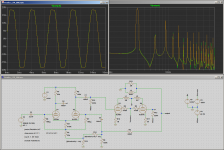They weren't marketed to guitarists at first, so it probably started with *one* bluesman who found a second-hand or pawn-shop Bassman at an affordable price, because bass players wouldn't touch the things once they discovered they destroyed speakers and didn't produce much bass doing it.
People keep forgetting what the state of the art was back then. "The Bassman has four inputs." Not like there will be four bass guitars being used, or the bass player has four basses and he is too lazy to change cords. Thes amplifiers were PA equipment. The bass, guitar and vocals would most likely go through the amp. Leo trying to sweeten up the sound? Hardly, as his progression went till his company after Fender he was looking for clean sound.
And of course with the guitar and bass plugged into the amp, a guitar player just had to turn the amp up all the way to see what it could do. And it also pee'ed off the bass player.
We just put together some pretty convincing evidence that the feedback scheme was either a mistake, or a deliberate mis-connection to allow re-using old turret boards.
I meant to get back to this a while back, to know where the feedback location came from you have to look at the 5F6 schematic rather than the 5F6A. The presence control is a part of the EQ, and the NFB is returned through the presence control. Probably not the best place to return it back to, might mess up the EQ, it being in the NFB loop. So using the same board, just return the NFB to the tail by using one wire moving from the top of the presence pot.
Same idea as returning the NFB to the gain stage of the Cathodyne. Just a resistor that allows you to stack a inverted voltage at the bottom of an amplifying stage. The LTP stage has gain, why can't you do the same? I am sure Leo moved it over and heard a reduction in gain when doing that. "Hey, it works."
That sounds like the basis for an entire new thread. 🙂...THAT would be the 5F6A---generally regarded as the best sounding of all the Bassman amps...
I know many guitarists love presence controls, and some find them absolutely mandatory.
Now that I have one Bassman schematic modelled in LTSpice, and the grunt-work is done, it won't take a lot of work to model another variation on the theme. LTSpice does frequency response plots too, so things like the effect of a presence control can be studied.
Thanks for that. What, I wonder, did they patent about it? And does Weber mention whether Fender or AT&T came up with the accidentally distorting cathode follower in the preamp?"...Leo Fender did not design the Bassman circuit...patented by AT & T and Western Electric in 1948..."
That he certainly did. 🙂 De Armond's pre-WWII single-coil guitar pickup design, Paul Bigsby's headstock and "plank" solidbody designs, Paul Tutmarc's 32" scale, fretted, solid-body electric bass, the list of good things Leo spotted goes on. 😀Leo just knew a good thing when he saw it! At least give him credit for that!
-Gnobuddy
Thanks for that reminder. That's really a very good point!...The bass, guitar and vocals would most likely go through the amp...
Those days were before my time, but I remember that the lyrics to Lobo's song "Rock and Roll Days" includes the line "The band all played through one amp".
That sounds extremely plausible, and I think Merlin Blencowe came to more or less the same conclusion....the 5F6 schematic rather than the 5F6A...
...I am sure Leo moved it over and heard a reduction in gain when doing that. "Hey, it works."
-Gnobuddy
Thanks for that reminder. That's really a very good point!
Those days were before my time, but I remember that the lyrics to Lobo's song "Rock and Roll Days" includes the line "The band all played through one amp".
That sounds extremely plausible, and I think Merlin Blencowe came to more or less the same conclusion.
-Gnobuddy
When we were kids my cousin had a Twin the bass player had a SS Ampeg with two 15's. We put the vocals through the bass amp until we rigged up some monitors. Even with the 15's it was cleaner than going through the Twin given my cousin liking some dirt.
Speaking of dirt, here's a screenshot of the Bassman LTSpice simulation deep into clipping....Twin...some dirt.
I don't know how much we can trust the vacuum tube models when the amp is pushed this far, but for what it's worth, this is the result of the simulation.
Clipping looks pretty abrupt, probably because of the negative feedback. There is a forest of spikes in the FFT, with lots of unpleasant-sounding higher harmonics; this is no gentle "tubey" distortion, but something much more abrupt and crunchy.
And there is still no benefit (or disadvantage) to be seen from Leo-feedback. The green and yellow-brown curves fall almost perfectly on top of each other in both the waveform and spectrum plots.
-Gnobuddy
